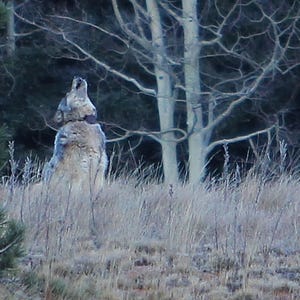State officials defended their actions Thursday, saying they determined it was inconclusive if the sighting was a wolf and noting that the hunter wasn't participating in the bounty program.
The 3-year-old female wolf — named "Echo" in a nationwide student contest — was killed in December 2014 in southern Utah after capturing the attention of wildlife advocates across the country because it was the first seen near the Grand Canyon in seven decades.
Wildlife advocates called the death of an animal protected in Utah under the Endangered Species Act heartbreaking and were dismayed when the hunter wasn't charged after an investigation by U.S. Fish and Wildlife .
The Center for Biological Diversity said in a letter sent Wednesday to state officials that they didn't do enough after the wolf sighting in November 2014.
"Your department and division bear significant culpability for encouraging the wanton killing of coyotes when division staff were aware an endangered wolf was present," wrote Michael Robinson of the Center for Biological Diversity.
In an interview with The Associated Press, Robinson said the state could have saved "Echo." ''We should expect more from public servants," he said.
The wolf sighting was reported by two men who sent a picture of an animal crossing a road east of Cedar City — about 65 miles from where "Echo" was killed, show public records obtained by the Center for Biological Diversity. The men told state officials they had been around coyotes their entire lives and that this animal looked like a wolf because of its color, facial features and size. The animal was as tall as a guard rail on the highway that went up to their hip, they said.
They also reported seeing a black collar with a silver box on the animal. The wolf who was killed had worn a radio collar since January 2014.
State officials looked into the sighting and found some aspects consistent with a wolf, while others looked off, said Kim Hersey of the Utah Division of Wildlife Resources. Though they couldn't see a radio collar in the picture, they checked for radio frequencies for wolves but that didn't yield any results, she said.
They were prepared to follow up if more sightings came in, but that didn't happen, Hersey said. The state receives about 100 reported wolf sightings a year, with the majority turning out to be coyotes or wolf-dog hybrids, Hersey said. Currently, there are no known wolves in Utah.
Though a picture may seem to lend credibility to a sighting, state officials were cautious because photos can be digitally altered, Leslie McFarlane of Utah Division of Wildlife Resources said. "Based on wolf biology, if an animal were to settle in an area you would expect to get repeated sightings," Hersey said. "Since we never heard anything else, we didn't go back out looking."
Wolves and coyotes often have similar coloring, but wolves are usually twice as large. But how well a person can distinguish depends on the lighting, the distance and how much experience a hunter has comparing the two animals.
There are at least 13 documented cases since 1981 in which hunters have shot a wolf thinking it was a coyote, according to the Center for Biological Diversity. That figure includes the recent incidents in Utah and Colorado.
The Center for Biological Diversity is calling on Utah to implement a mandatory suspension of the bounty program within 200 miles of a credible wolf sighting. The center also wants more education programs for licensed hunters to learn how to differentiate between coyotes and wolves.
McFarlane said state officials are making changes to training required of participants in the bounty program so they can clarify the difference between wolves and coyotes.
When wolf sightings are verified, the state alerts U.S. Fish and Wildlife, and sometimes, the public, Hersey said. "We're not trying to keep wolves in the state a secret," Hersey said.
source



I think the hunter knew very well that what he shot was a wolf.
ReplyDelete